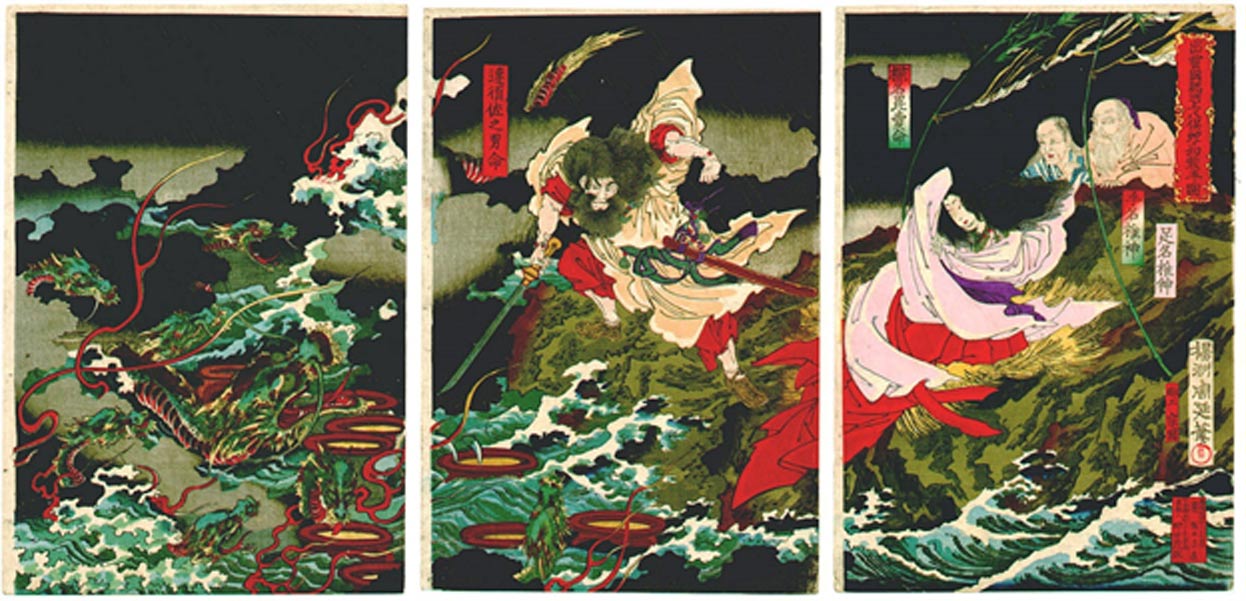
Age of the Gods: Japanese Creation Stories and the Descendants of Deities
Nihon or Nippon is a Chinese pronunciation for the country that was originally called Yamato. As the islands lie to the east of the Asiatic continent, the Chinese called the land sun-origin. This name was further changed by Marco Polo who gave it as Zipangu which eventually became Japan.
The Oldest Chronicle
Over 1300 years old, the Kojiki is Japan's oldest existing chronicle. Compiled by Yasumaro, a Japanese nobleman and renowned chronicler, at the command of the Empress Genmei in 712, the Kojiki is a collection of the myths and stories that tell the ancient Japanese story of the creation of the universe, in particular the islands of Japan.
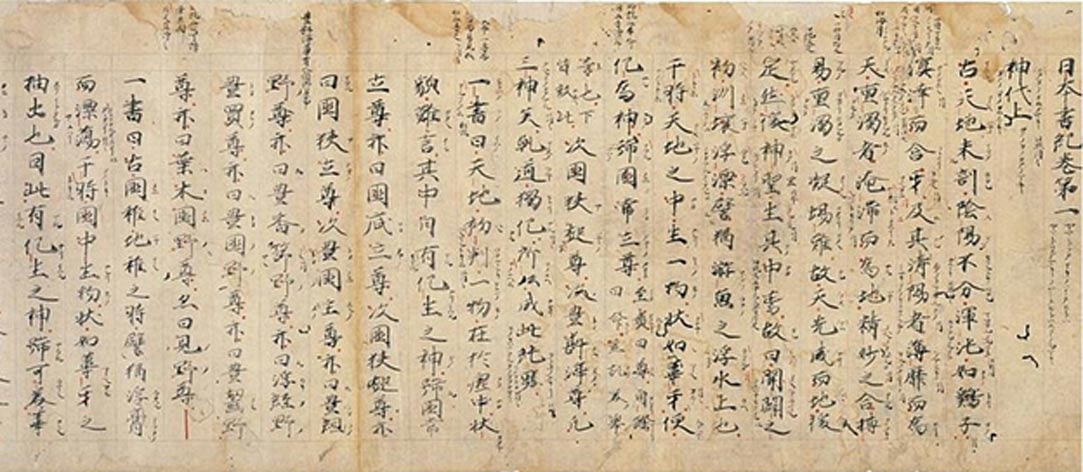
The Age of Gods, chapters from The Chronicles of Japan, 1286 (Public Domain)
Beginning in the Kamiyo or Age of the Gods, the Kojiki traces a path down through the mythical and ends in the known historical record with the lineage of Japan’s Imperial family. Yasumaro states that he submitted his manuscript to Empress Genmei on the 28th day of the first month of the year 712. He begins the preface to the Kojiki with an account of the first divine beings and the successive eight generations of brother and sister pairs until we arrive at the creator pair of Izanagi and Izanami.
The Birth of Everything
As is common to so many creation myths, everything begins in a state of chaos. In this chaos was heard the sound of particles moving. Light and the lightest particles drifted up and formed the upper layers of the universe. Light was at the very top, below that the lighter particles formed the clouds and Heaven, while the heavier particles settled and formed the Earth.
I Yasumaro say: Now when chaos had begun to condense, but force and form were not yet manifest, and there was nought named, nought done, who could know its shape? Nevertheless Heaven and Earth first parted, and the Three Deities performed the commencement of creation; the Passive and Active Essences then developed, and the Two Spirits became the ancestors of all things.
The first three deities are the Master-of-the August-Center-of-Heaven, the High-August-Producing-Wondrous-Deity and the Divine-Producing-Wondrous-Deity.
The second important Japanese record is the Nihongi, presented to the same Empress Genmei only eight years after the Kojiki tells us that:
At this time a certain thing was produced between Heaven and Earth. It was in form like a reed-shoot. Now this became transformed into a God, and was called Kuni-toko-tachi no Mikoto.
Izanagi and Izanami
There follows a series of deities who all hid themselves, all with differing names depending on which source one refers to, until we end with the two spirits representing the Passive and Active Elements; these are the creator pair, brother and sister, Izanagi and Izanami.
During this lengthy period all that was heavy in the void had precipitated into a nebulous mass. The Heavenly deities got together and commanded Izanagi and Izanami to go down to the proto-land below and create terra firma. The pair was given the jewel encrusted spear, Ama-no-Nubok and was told:
We bestow on you, this precious treasure, with which to rule the land, the creation of which we command you to perform.
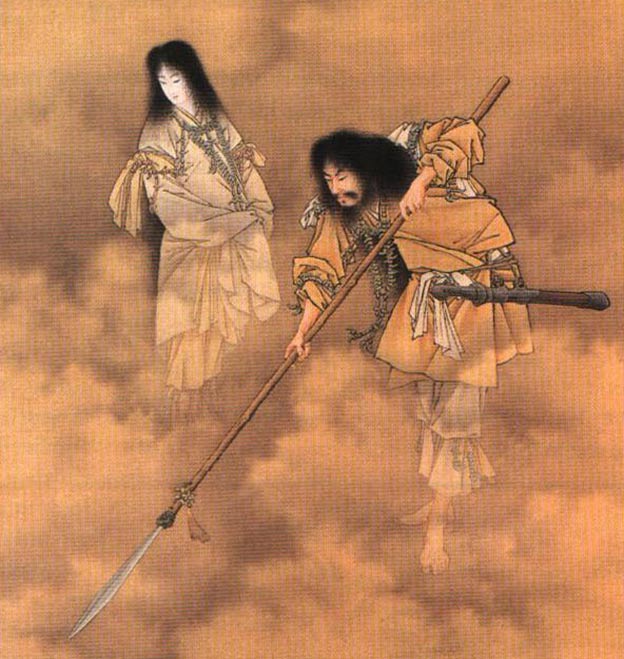
Detail; Izanagi with spear Amenonuhoko to the right, Izanami to the left. (Public Domain)
The Divine couple left, spear in hand, for the Floating Bridge of Heaven, which stretched between the heaven and the earth. What they saw as they looked down was a sweet smelling liquid fog and at first they had no idea how to proceed. Izanagi pushed the spear into the liquid until it hit something solid. He pulled out the glistening spear and as it rose so drops fell from the tip. These drops immediately coagulated into solid land, the island that is today called Onkoro. The two deities left the bridge and went down to the newly formed island. This was to be their new home. Wishing to get married they built, in the center of the island, a Heavenly Pillar and built around it a great palace called the Hall of Eight Fathoms. After a couple of false starts the Divine Pair produced children.
The Birth of Land, Mountains and Plains
First, the island of Awaji was born, next, Shikoku, then, the island of Oki, followed by Kyushu; after that, the island Tsushima came into being, and lastly, Honshu, the main island of Japan. The two deities then set about creating more gods to look after all aspects of their new found country.
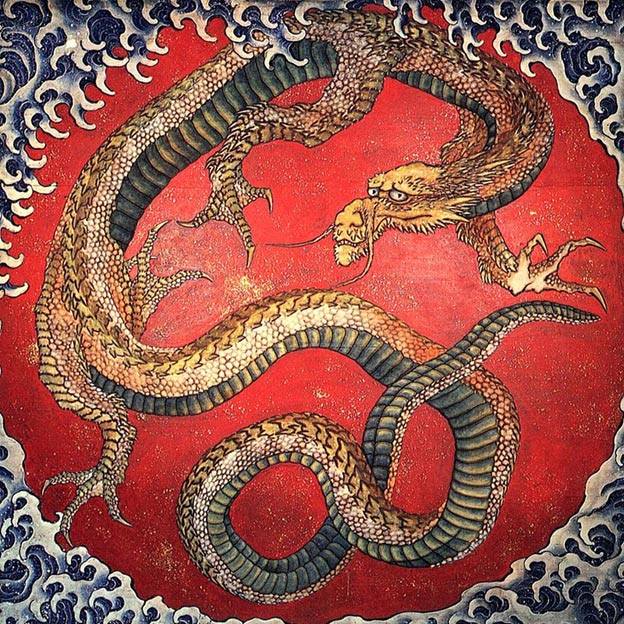
Owatatsumi-no-Kami was said to be a creationary force, Kami, in the form of a dragon. (Public Domain)
Their first-born proved to be the sea-god, Owatatsumi-no-Kami. Next they gave birth to the patron gods of harbors, the male deity Kamihaya-akitsu-hiko having control of the land and the goddess Haya-akitsu-hime having control of the sea. Next Izanagi and Izanami gave birth to the wind-deity, Kami-Shinatsuhiko-no-Mikoto. At the moment of his birth, his breath was so potent that the clouds and mists, which had hung over the earth from the beginning of time, were immediately dispersed. In consequence, every corner of the world was filled with brightness. Kukunochi-no-Kami, the deity of trees, was the next to be born, followed by Oyamatsumi-no-Kami, the deity of mountains, and Kayanuhime-no-Kami, the goddess of the plains.
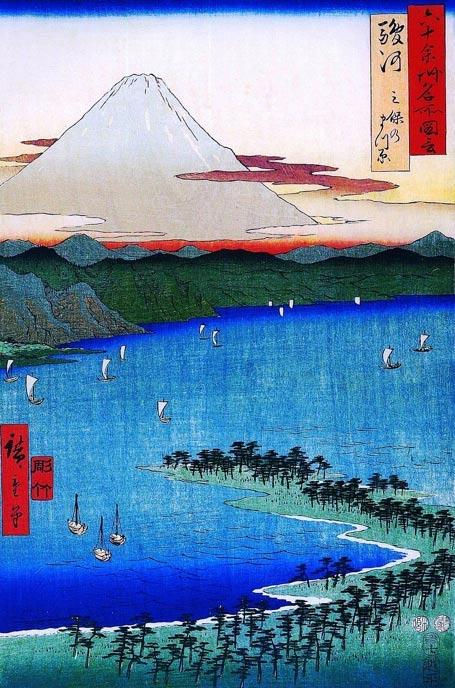
Traditional Japanese artwork with Mount Fuji in the distance. (Public Domain)
However, during the birth of the Fire-God, Izanami was badly burned. She died and went to the Land of Gloom. In his anguish, Izanagi snatched up his sword and slew the Fire-God but to his surprise another eight deities sprang from the blood on the sword, and then another eight grew from the Fire-God’s corpse.
Yomi, Land of the Dead
Izanagi then descended into Yomi, the land of the dead, and there found his wife and sister Izanami. Izanami greeted him, telling him it is too late, she had already eaten from the kitchens of Hades. She then tells him she will go and ask the deities of the Underworld to let her return to the land of the living, however, there is a condition; Izagani is forbidden to look at his wife.
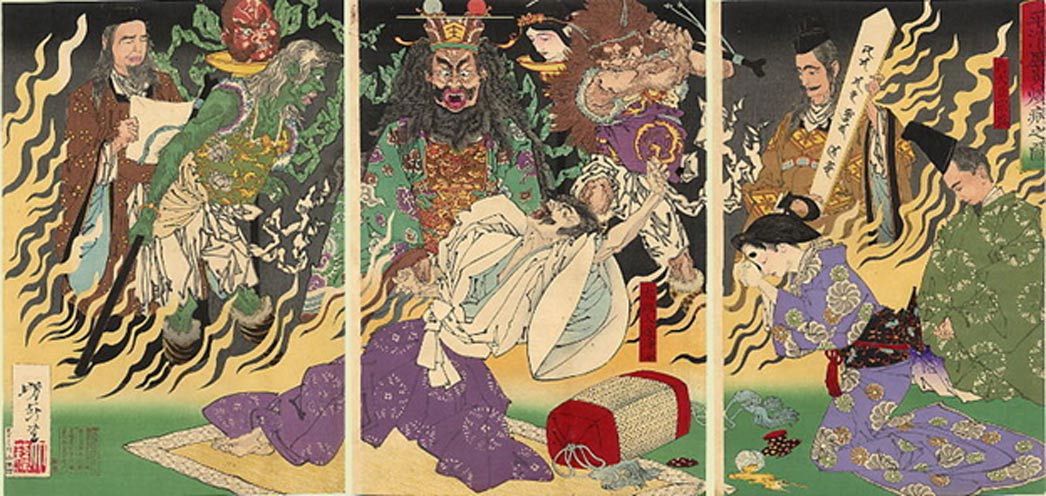
The Land of Yomi and Enma, the King of Hell. Tsukioka Yoshitoshi, The Fever, 1883. (Public Domain)
Izagani grew impatient and lit a torch. He saw his wife had become a rotting corpse and ran away. Izanami was furious with Izagani for not respecting her wishes and sent all sorts of monsters after him, crying out “Thou hast put me to shame”. Izanagi managed to escape by rolling a huge rock into the path of his wife, thereby blocking the road to Yomi.
…and they stood opposite to one another and exchanged leave-takings; and Her Augustness the Female-Who-Invites said: "My lovely elder brother, thine Augustness! If thou do like this, I will in one day strangle to death a thousand of the folks of thy land." Then His Augustness the Male-Who-Invites replied: "My lovely younger sister, Thine Augustness! If thou do this, I will in one day set up a thousand and five hundred parturition-houses. In this manner each day a thousand people would surely be born." So Her Augustness the Female-Who-Invites is called the Great-Deity-of-Hades.
Izanagi, feeling unclean after his contact with the dead, decided to cleanse himself in a river. As he undressed, so more deities were born from each item discarded. As he entered the waters more deities, both good and bad were born. As he washed his left eye so the Sun-Goddess Amaterasu appeared, the Moon-God Tsuki-yomi appeared from his right eye, and Susano-o came from his nose.
Hiding the Sun
Proud of these three noble children, Izanagi divided his kingdom among them. He gave Susano-o control of the oceans, Tsuki-yomi controlled the night, and he made Amaterasu the ruler of the sun and the heavens.
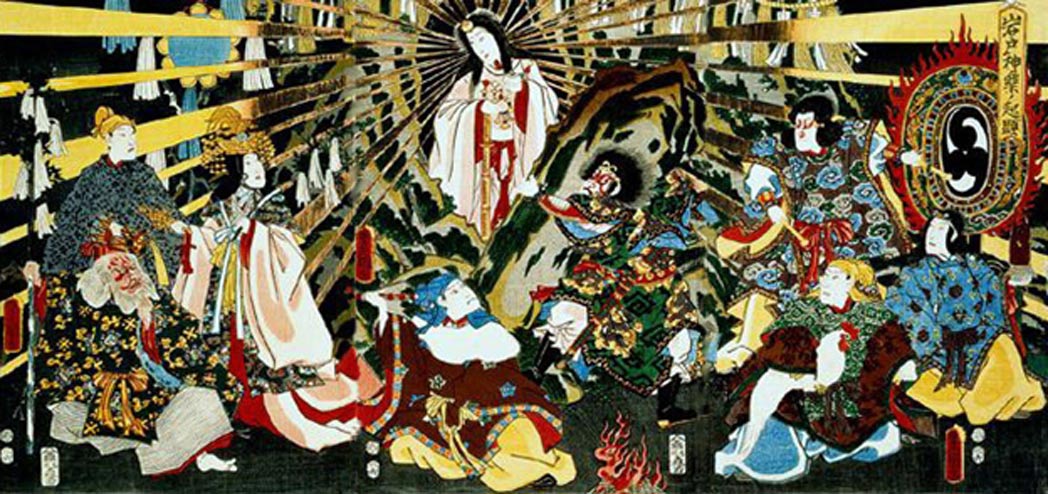
Japanese Sun goddess Amaterasu emerging from a Cave. (Public Domain)
Susano-o, never happy with his lot, spent most of his time causing trouble for his sister, the Sun-Goddess. He set about destroying her ditches and irrigation systems that kept the rice fields going by filling them up with mud and breaking down the field divisions. He even went as far as defecating in her palace. Amaterasu kept forgiving him, which probably made him worse, until one day, while the Goddess and her ladies were weaving; Susano-o tore open the roof and dropped a dead horse on them. This upset Amaterasu so much that she hid herself in a cave and wouldn’t come out. The world was plunged into darkness as the Sun shone no more. The rice fields began to die in the perpetual night. Everybody went hungry.
Then the Goddess Uzume had an idea. She organized a big party outside the cave with lots of Gods and Goddesses as guests. She placed an ornate mirror and a jeweled necklace in front of the cave and then proceeded to perform an erotic dance on top of an upturned tub.
…before the door of the Heavenly Rock-Dwelling, and stamping till she made it resound and doing as if possessed by a Deity, and pulling out the nipples of her breasts, pushing down her skirt-string usque ad privates partes.
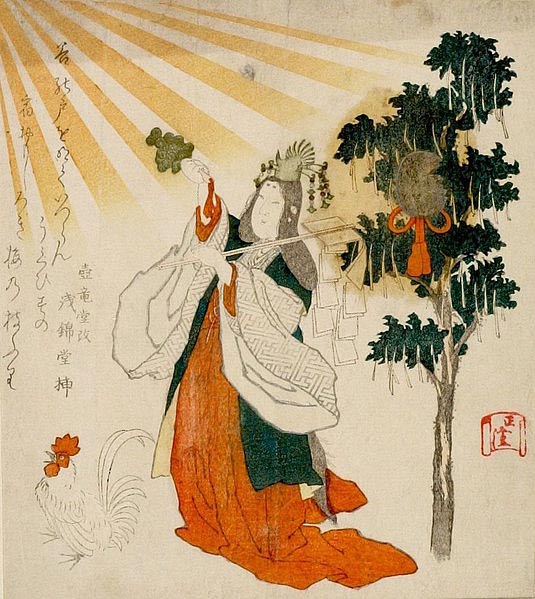
The Goddess Uzume with Rooster and Mirror (Public Domain)
(“usque ad privates partes” translates as “all the way to her private parts” – a striptease in effect. In his translation Chamberlain uses Latin to convey any parts of the text considered unmentionable by the Victorians.)
The dance got more and more frantic and soon all the guests were cheering and laughing. They made so much noise that Amaterasu became inquisitive and she pushed open the rock door to her cave a little so that she could peek out. The first thing she saw was her wondrous self in the mirror. As she stood there transfixed by her own beauty, the other Gods quickly pulled her out of the cave and sealed it shut. Amateratsu returned to her rightful place in the Heavens and the Sun shone once more. To this day Amateratsu is represented in temples by a mirror.
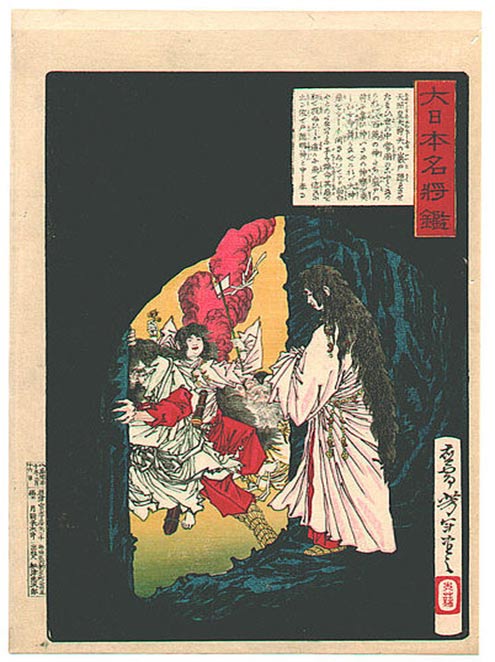
Amaterasu Ōmikami appearing from the cave. (Public Domain)
The Sun-Goddess coming forth from the Rock-Cave now illumined the sky and consequently the spectators were enlibled to distinguish one another’s faces once more. Over flowing with joy, they loudly cried:
“Ahare! ahare!” (signifying that the sky is now illuminated)
“Ana omoshiroshi!” (“O how delightful it is again clearly to see one another’s faces!”)
“Ana tanoshi!” (“What joy to dance with outstretched hands!”)
“Ana sayake oke!” (“How refreshing and reviving! just like the rustling sound of breezes softly whispering in bamboo grass, or through the leaves of the trees playing sweet melodies of natural music!”)
Then the two Gods Ame-no-Koyane-no-Mikoto and Futotama-no-Mikoto respectfully besought the Sun-Goddess never more to hide her face.
Orochi, the Great Serpent
Susano-o was banished from Heaven and so came to the land of Izumo, there he met an elderly couple who told him of Orochi, a great serpent with eight heads (eight in early Japanese carried the concept of many rather than a specific number) that yearly ate one of the daughters of the village. That particular year it was the fate of Princess Kusinada. The banished god asked for the girl’s hand in marriage if he could defeat the monster. That night he set bowls of sake for the serpent to eat and when it was quite drunk Susano-o cut off all its heads.
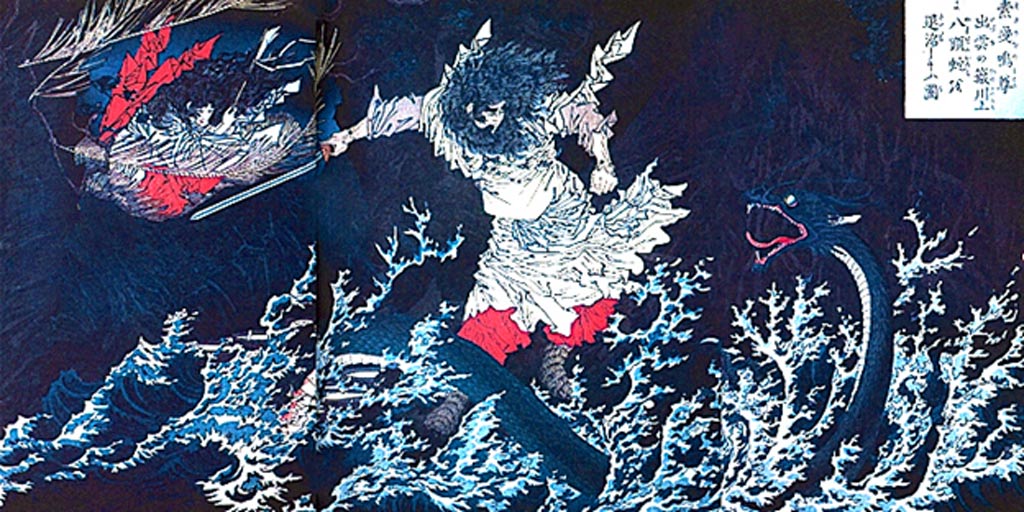
Susanoo slaying the Yamata no Orochi (Public Domain)
…the eight-forked serpent came truly as [the old man] had said, and immediately dipped a head into each vat, and drank the liquor. Thereupon it was intoxicated with drinking, and all [the heads] lay down and slept. Then His-Swift-Impetuous-Male-Augustness drew the ten-grasp sabre that was augustly girded on him, and cut the serpent in pieces.
As Susano-o cut into the body of Orochi, the blade of his sword broke. Thinking this strange, he cut open the flesh and discovered a magnificent sword in its tail. Susano-o gave the sword, called Kusanagi, to his sister, Amateratsu, as a peace-offering. The sword, along with the mirror and necklace that hung outside Amateratsu’s cave now form the Imperial Regalia. After this incident, Susano-o became the ancestor god of Izumo.
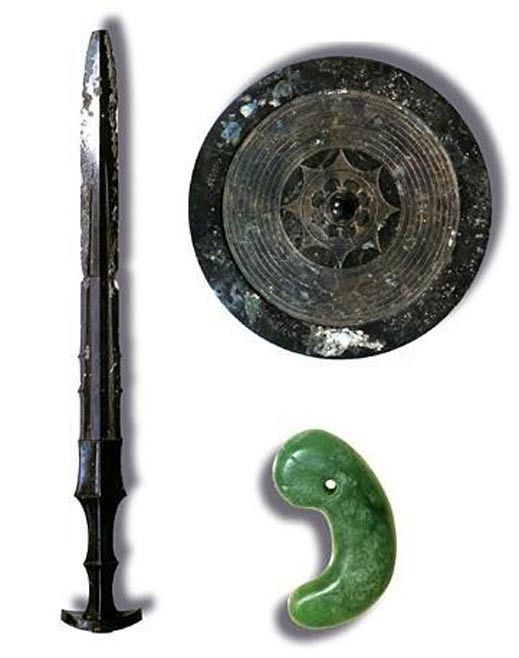
The Imperial Regalia: Sword, Mirror and Jewel/Necklace (Public Domain)
The Descendants of Okuninushi
Susano-o married Kusinada and they had many children. One of these was Okuninushi, Master of the Great Land. When he was younger his eighty brothers hated him because they all wanted the princess Yakami, but she had been promised to Okuninushi. The brothers got together and planned to kill Okuninushi.
On this mountain there is a red boar. So when we drive it down, do thou wait and catch it. If thou do not wait and catch it, we will certainly slay thee." Having spoken, they took fire, and burnt a large stone like unto a boar, and rolled it down. Then, as they drove it down and he caught it, he got stuck to and burnt by the stone, and died. Thereupon Her Augustness his august parent cried and lamented, and went up to Heaven, and entreated His Divine-Producing-Wondrous-Augustness, who at once sent Princess Cockle-Shell and Prince Clam to bring him to life.
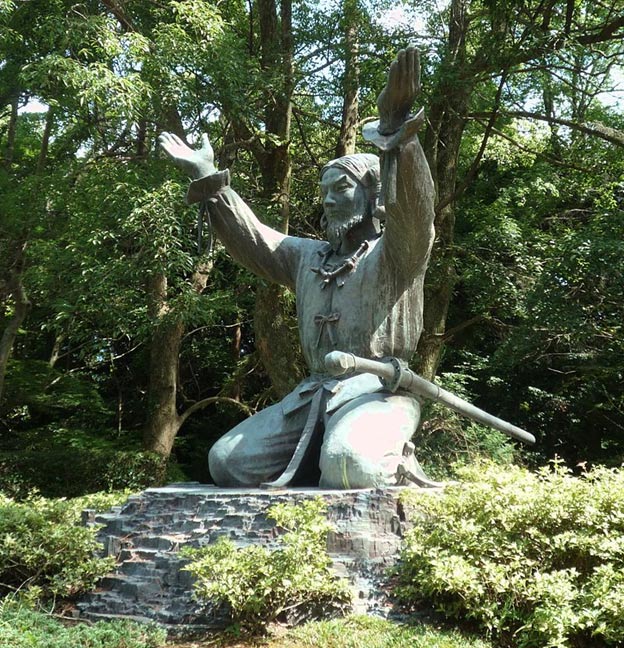
Bronze statue of Ōkuninushi in Japan. (CC BY 3.0)
Between them they made a paste of shell and water and smeared it all over Okuninushi, whereupon he became a beautiful young man, and wandered off. But the eighty brothers had another plan. They dragged him into the mountains where they found a tree with a crack in it. They forced Okuninushi through the crack, sealed it up and left him stuck inside the tree. Again his mother rescued him and brought him back to life. Okuninushi fled to the underworld and there fell in love with the daughter of Susano-o, his half-sister the Princess Suseri.
Susano-o set his son three tests which he must pass to gain the hand of the Princess. Okininushi passed all three with the help of Suseri and was then made Lord of All Earth by Susano-o. He ruled the land until he abdicated in favor of Amateratsu’s grandson Ninigi, the first sovereign to come down from Heaven and live on Earth and the start of the Japanese Royal line.
Featured image: Susanoo slaying the Yamata no Orochi, 1870s. (Public Domain)
References
Genchi Katō & Hikoshirō Hoshino, tr. Kogoshūi: Gleanings From Ancient Stories, Tokyo, 1926
Chamberlain B. H., tr.,The Kojiki, 1882
Aston W. G., tr., Nihongi, London, 1896
Isobe, Y., The Story of Ancient Japan, or, Tales from the Kojiki, Tokyo, 1928